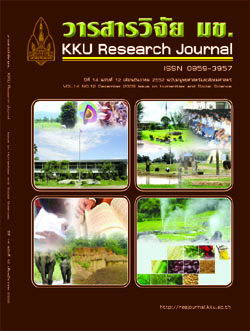Factors influence health security of rural families
Main Article Content
Abstract
The objective of this study was to describe the factors influencing health security of rural families. It was a quantitative study. Data was collected through questionnaires and distributed to households within the Nong Bua Lam Phu Province during July - August 2009 covering 339 samples and was analyzed by LISREL. This paper shows that three factor components which influence health security of rural families consist of: Group 1 the factors within family such as (1) family association, (2) health potential in family and (3) kinship associations; Group 2 the factors within community including (1) organizations within community, (2) association of family with community, (3) natural resources within community and (4) the community health system; and Group 3 the external community factors consisting of (1) the government health system, (2) promotion for health access by local administration and (3) health promotion through health networks. The findings show that the factors which influence health security of rural families are as a follows: firstly, the factors within the community (λ=0.86), secondly, the external community factors (λ =-0.71) and finally the factors within the family (λ=0.66). These factors are called the "Social Capital" and have shown the power to predict health security of rural families at 57.0% (R2 = 0.57). We recommend that strategic health policies should be concerned with çSocial Capitalé increase.
Article Details
References
UNDP.2001. Human Development Index. HumanDevelopment Report. [online] [Cite 1 July2008]. Available from http://hdr.undp. org/reports/global/2001/en/pdf/hdi.pdf
Cohen, J. 1977. Statistical Power Analysis for theBehavioral Sciences. Lawrence ErlbaumAssociate.
Elinor Ostrom. 2000. Collective Action and theEvolution of Social Norms. Journal ofEconomic Perspectives, AmericanEconomic Association 14 (3): 137-158.
John Field.2008.SOCIAL CAPITAL. Second Edition,published in USA and Canada. ByRoutledge, London and New York.
Woolcock, M. 2001. The place of social capital inUnderstanding Social and EconomicOutcomes. ISUMA Canadian Journal ofPolicy Research 2 (1): 11-17.

